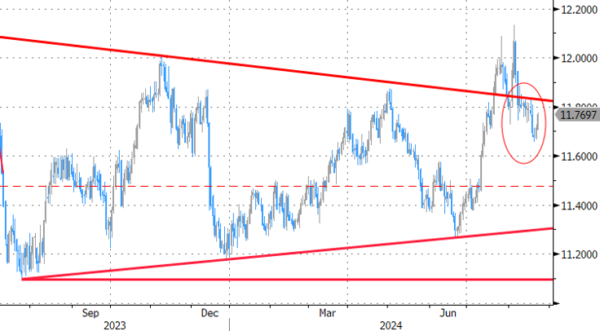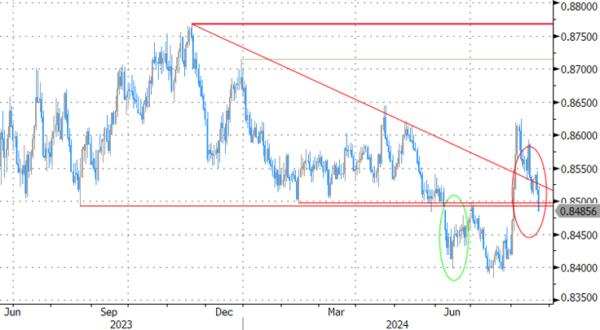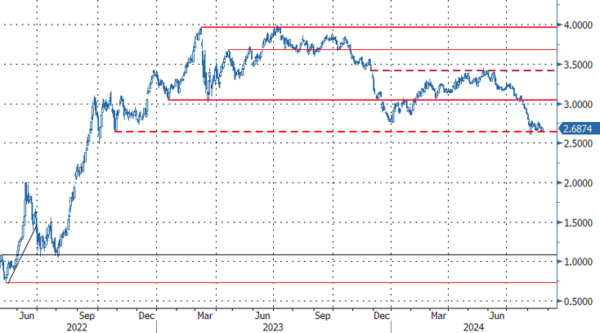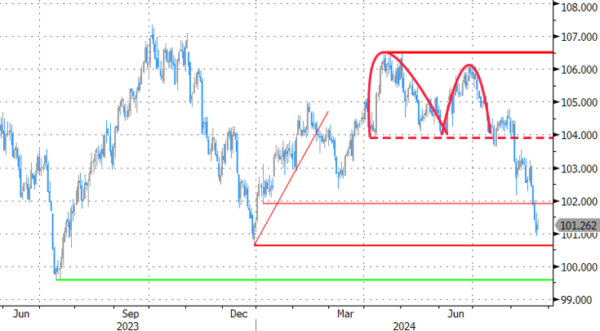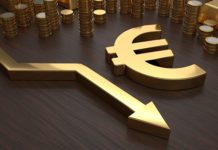Markets
European data today managed to temporarily steal attention away from the US. August PMI figures showed EMU business activity rising at a faster pace, but there’s more than meets the eye. The composite PMI ticked up to 51.2 (3-month high) whereas consensus expected a stabilization at 50.1. The EMU manufacturing remains deeply mired in recession territory (45.6 from 45.8) with the services sector outperforming (53.3 from 51.9). It’s unsure whether the domestic services industry will remain as strong in coming months given that this month’s improvement is largely due to a stellar performance of France (55 from 50.1), linked to the 2024 Paris Olympics. Germany underperforms, with the composite measure sliding further into contraction territory (48.5 from 49.1; weakest since March). Underlying details of the composite PMI were also less positive. New orders continued to fall, while there was a broad stagnation of staffing levels across the EMU amid the lowest business sentiment YtD. Meanwhile, the rate of input cost inflation eased to an eight-month low, but companies raised their selling prices at the fastest pace since April. Services charges rose at the sharpest pace in three months, while manufacturing output prices increased for the first time since April 2023. The ECB might find some reassurance in the latest price indices though as input costs in the services sector (proxy for wages), rose at the slowest pace in 40 months. After the PMI, the European central bank announced that Q2 negotiated pay rose 3.6% from a year ago, down from 4.7% in Q1. It’s one of the key metrics they follow to decide whether underlying price pressure are fading, allowing for a less restrictive monetary policy. Minutes of the July ECB meeting later showed consensus that the September meeting was a good time to re-evaluate the level of monetary policy restriction. The complex of EMU figures failed to inspire trading, apart from a brief EUR-uptick following French PMI’s (released earlier than German/EMU data). Today’s price action (ahead of US PMI’s) was more a modest reversal of this month’s strong trends with both core bond yields (up to +4 bps at front end of US yield curve) and the dollar (EUR/USD 1.1140) recovering some ground. Fed comments included Kansas City Fed Schmid who wants more data before supporting a rate cut. Based on yesterday’s FOMC Minutes, that’s the minority view on the board for now. Schmid added that yesterday’s payrolls revisions didn’t change how he thinks on monetary policy. Boston Fed Collins argued that a gradual pace of cutting is likely appropriate. Gradual is the magic word returning in Fed speeches. They suggest the central bank will kick off with a regular 25 bps rate cut instead of large 50 bps one at the mid-September FOMC meeting.
News & Views
Norwegian Q2 GDP growth jumped by 1.4% Q/Q, but this was mainly due to an unusually high level of activity for the time of the year in oil and gas extraction (5.6% Q/Q) related to higher gas maintenance work carried out last year which allowed to keep production higher in Q2. Growth in the mainland economy was much more subdued at 0.1% Q/Q (vs 0.2% expected) following a downward revision for Q1 (0.2% to 0.1%). Household consumption rose a strong 1.6% Q/Q (sharp rise in car registrations). Final domestic use of goods and services declined slightly however. Other data also suggest subdued activity with the number of employed persons unchanged from Q1 while the number of hours worked decreased 0.1% Q/Q. The Norges Bank recently indicated that it intended to keep the policy rate stable at the current level of 4.5% for some time, amongst others to prevent an inflationary impact from the weak krone. Softer than expected H1 growth at some point might still open the debate on a NB rate cut before the end of the year. The market currently discounts a 25 bps cut in December. EUR/NOK rose from 11.71 to 11.76.
Belgian consumer confidence improved from -5 to -3 in August. All components of the indicator picked up this month without however making up for the downturn observed last month. Belgian consumers expressed significantly more optimism about the general economic situation going forward, with their expectations reaching the most favorable level seen since the start of the year (-10 from -16). Their sentiment concerning the development of unemployment also improved, albeit only marginally (18 from 19), without making up for the sharp deterioration recorded last month (19 from 12 at that time). On a personal level, households expect to see a modest improvement in their financial situation in the coming twelve months (-1 from -2) and intend to save more (18 from 16).
Graphs
EUR/NOK: disappointing GDP data open door for change of heart at Norges Bank
EUR/GBP: sterling outperforms on stronger UK PMI’s
EU 2y swap rate joins today’s broader move, rising slightly away from recent lows
Trade-weighted dollar (DXY): a moment of reprieve




